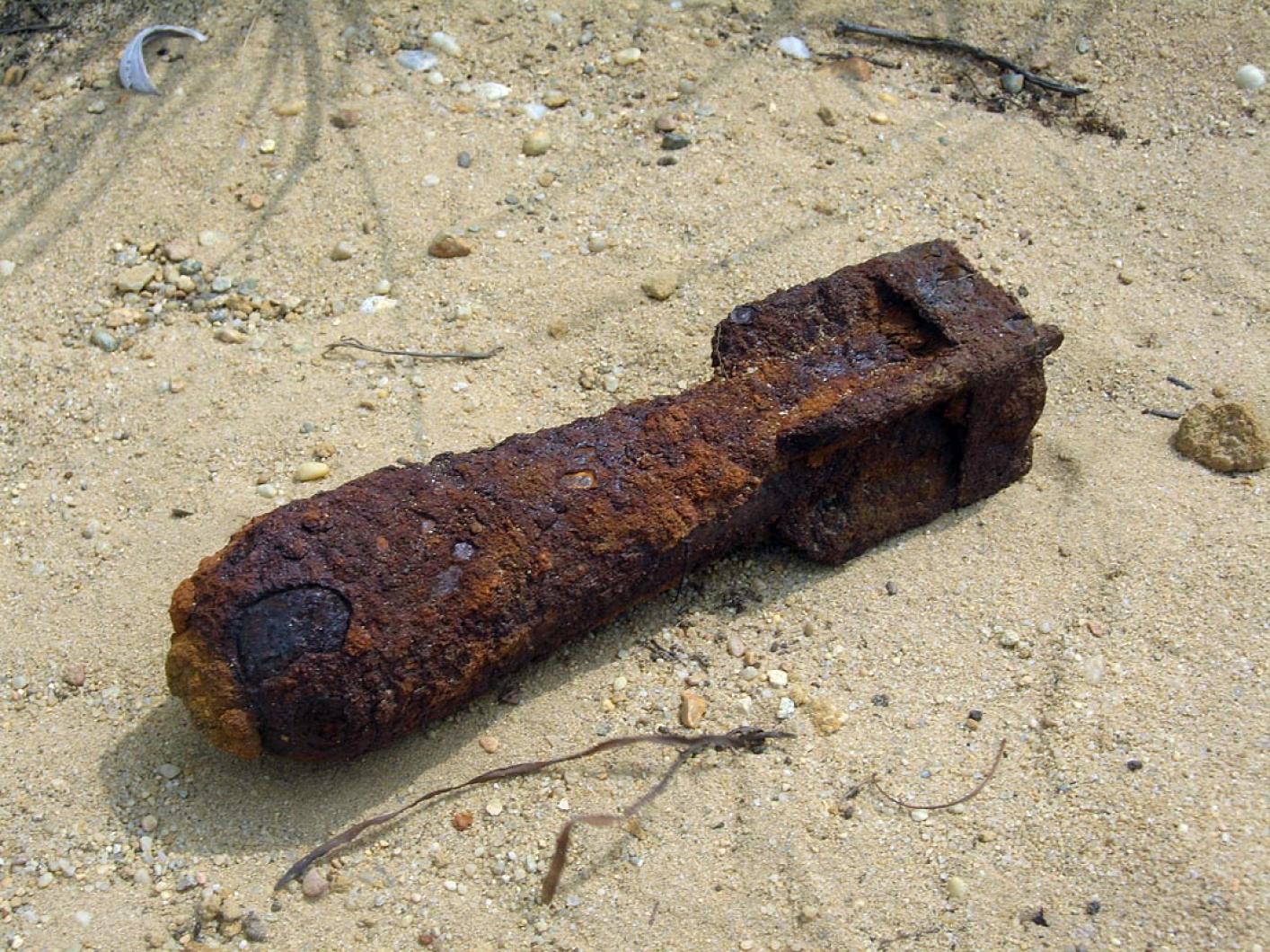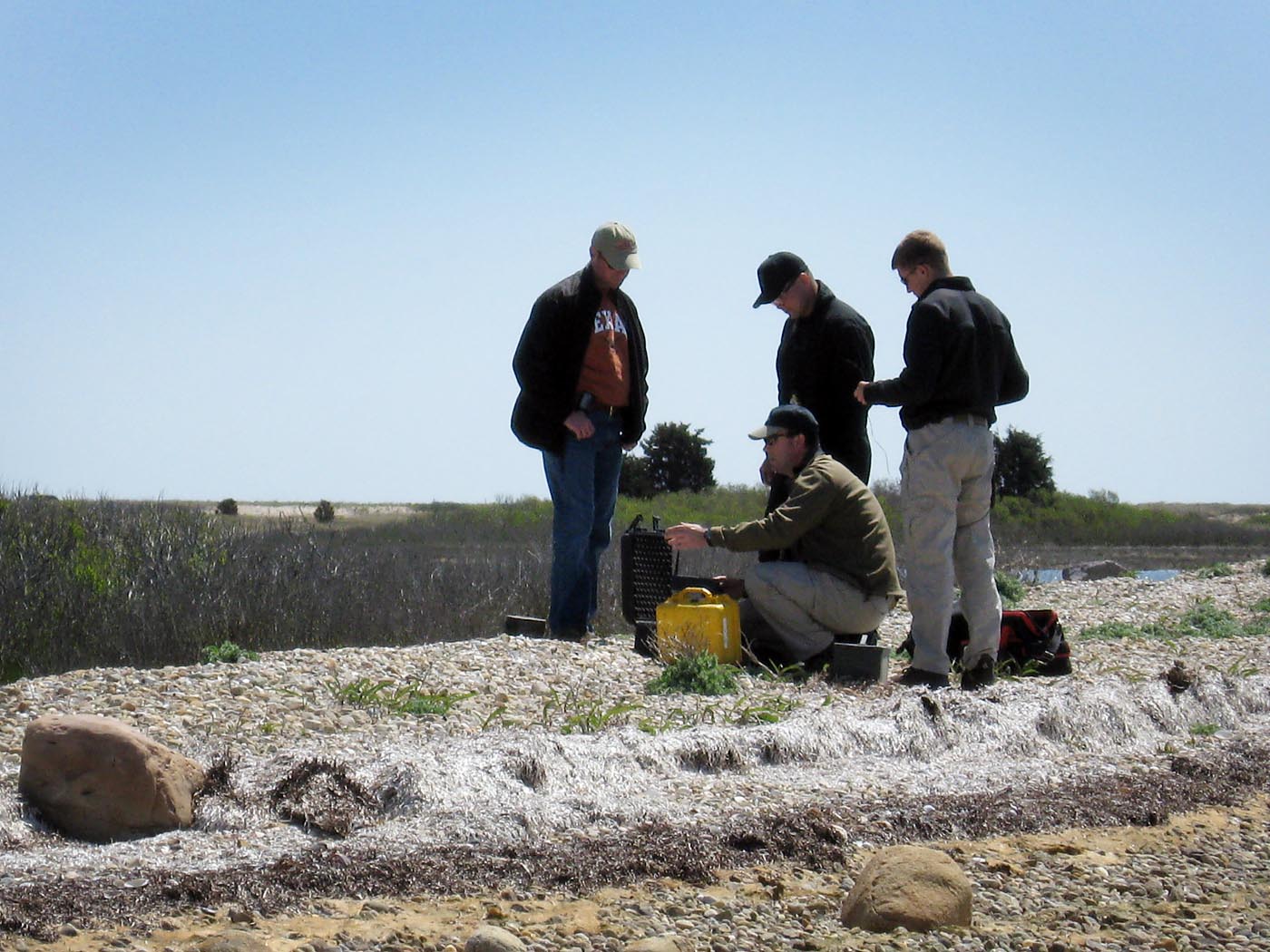A bomb squad from the Massachusetts State Police detonated several pieces of unexploded ordnance left over from World War II on Chappaquiddick last Wednesday, sending a thundering boom across the island and rattling foundations from Cape Pogue to Sampson’s Hill.
The explosion prompted concerned calls to the Island communications center and Edgartown police department, and was the subject of speculation all across the tight-knit Chappy community for several days.
This week it was revealed that the explosion — which occurred around 11 a.m. on May 14 — was part of an operation conducted by the state police bomb squad in conjunction with the U.S. Navy and Army Corps of Engineers. The bombs were detonated on a remote site at Cape Pogue that is owned by The Trustees of Reservations.
Sgt. Jerry Galizio of the state police bomb squad said the munitions were MK-23 practice bombs dating back to World War II that measured about eight inches long and four inches in diameter which washed up on the shore of Little Neck and Cape Pogue in recent months. He said a total of four bombs were counter-charged and detonated, although it was unclear if they were inert or live munitions.
Several sites on the Island — including South Beach and Cape Pogue — were used extensively for dive bomb training and other munitions operations during World War II by military planes out of the Quonset Point Naval Air Station in Quonset, R.I.
Sergeant Galizio said it is common for ordnance to wash up on shore or be uncovered by erosion or construction projects. He estimated the state police bomb squad visits Chappaquiddick at least six times a year to detonate munitions that have been gathered either by emergency personnel or the Trustees. The sergeant said most of the munitions are not a threat to public safety, but he also stressed the public should not handle the ordnance under any circumstances.
“I would estimate that 90 per cent are inert, but that still leaves 10 per cent that might, under the right circumstances, detonate,” he said.
Chris Kennedy, the Island’s regional director for the Trustees, said unexploded ordnance is frequently found on properties owned by the Trustees, including at Little Neck in Cape Pogue Bay, at South Beach and at the Long Point Wildlife Refuge in West Tisbury. He said there is a distinction between a live bomb and an unexploded practice bomb.
Many practice bombs used for dive bomb practice during World War II were not functioning weapons, Mr. Kennedy said, but had a small explosive charge in the nose cone that shot out a red phosphorous pyrotechnic that signaled to the pilot where the bomb landed for training purposes. But he also said practice bombs and their small explosive charges can potentially be hazardous to people.
He too said finding unexploded ordnance is not new on the Vineyard, especially along the southern edge of the Island and on Chappaquiddick. Throughout the 1980s and 1990s, thousands of rusted warheads and practice bombs were pulled from the clay and sand of South Beach, including a 1,700-pound torpedo recovered in July of 1994.
The recovery efforts from 1989 to 1994 were so prevalent that portions of South Beach were closed to the public for long stretches while the military searched for and removed unexploded ordnance.
But Mr. Kennedy said the Trustees recently stepped up efforts to remove munitions after finding a 100-pound bomb at Wasque Point that was believed to have been filled with explosives. The Trustees also learned recently that the U.S. Navy leased Little Neck during World War II and used the area for dive bombing training.
Mr. Kennedy said the Trustees have been working with the Army Corps of Engineers to come up with a formal plan to search for and remove ordnance at Cape Pogue, a remote barrier beach visited by thousands of beachgoers, birdwatchers and fishermen. “We are looking to the Army Corps of Engineers to safeguard the visiting public. I think it is safe to say we view this as a priority,” he said.
He said new ordnance is uncovered on Chappaquiddick nearly every week.
“Even the smallest of these bombs, which are about three-pounds, have three grams of gun powder in them . . . and that is enough [to cause harm]. We have been told that between 10 and 30 per cent of these did not go off when they were dropped, and most have grown rusty and the nose cone and tail have become plugged up. Bottom line, if you drop them on the ground, they could go off,” he said.
He said munitions recovered on properties owned by the Trustees are routinely detonated by either a state police bomb squad or a demolitions team from the U.S. Navy. He also said there is no formal notification system to alert the public prior to the explosions.
“It’s a tricky thing, because we want people to know that these [bombs] are out there. But we also don’t want to make these bombs attractive nuisances; we don’t want people going and searching for them,” he said.
Mr. Kennedy said some people don’t think twice about collecting munitions when they come across one. He said people have shown up at his office with canvas sacks filled with the munitions, and he has heard that other people display them in their homes like trophies. “I think it’s an Island thing; people find them and use them as paper weights or doorstops,” he said.
He emphasized that people should not handle any ordnance, but should mark the area and then contact the proper authorities. “Just a few weeks ago a couple found an ordnance on the beach and picked it up and placed it on top of a dune so we could find it later. That is not a smart thing to do,” he said.
Carol Charette, operations manager for the Army Corps of Engineers, said yesterday that the New England District Corps of Engineers will conduct a preliminary assessment and inventory project report for the area.
She said the area from Wasque Point to Cape Pogue will likely be added to the Military Munitions Response Program, which means that an active operation will take place sometime in the future to locate and remove as many munitions as possible. Availability of funding will determine when the project is executed.
She also said the South Beach cleanup effort started in the late 1980s will be amended to extend the boundaries to Norton Point and Wasque.
And the corps will begin a monitoring program at South Beach, which will include awareness training, the distribution of pamphlets and periodic reviews. She also said the Army Corps plans to put up signs at South Beach and other locations warning people about the dangers of any ordnance they might find.
“There is still a chance that some of these might go boom . . . and even a small boom in most cases can do real damage,” she said.







Comments
Comment policy »